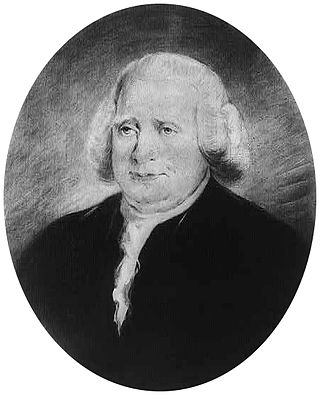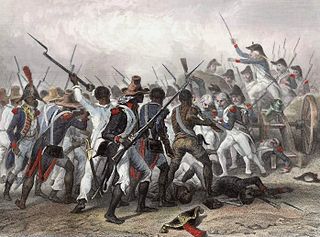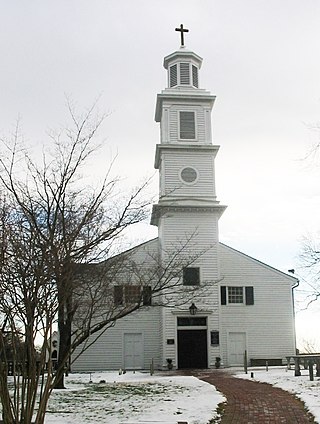
Charles City County is a county located in the U.S. commonwealth of Virginia. The county is situated southeast of Richmond and west of Jamestown. It is bounded on the south by the James River and on the east by the Chickahominy River.

Carter Braxton was a Founding Father of the United States, signer of the Declaration of Independence, merchant, and Virginia planter. A grandson of Robert "King" Carter, one of the wealthiest and most powerful landowners and slaveholders in the Old Dominion, Braxton was active in Virginia's legislature for more than 25 years, generally allied with Landon Carter, Benjamin Harrison V, Edmund Pendleton and other conservative planters.

Gabriel's Rebellion was a planned slave rebellion in the Richmond, Virginia, area in the summer of 1800. Information regarding the revolt was leaked before its execution, and Gabriel, an enslaved blacksmith who planned the event, and twenty-five of his followers were hanged. The site of Gabriel's execution was, for several years, believed to have been at the Shockoe Bottom African Burial Ground, historically known as the Burial Ground for Negroes. His execution was advertised as occurring at the usual place; however, in 1800, that may have been a location other than the Burial Ground for Negroes. The location of Gabriel's burial is also unknown.

Shirley Plantation is an estate on the north bank of the James River in Charles City County, Virginia. It is located on scenic byway State Route 5, between Richmond and Williamsburg. It is the oldest active plantation in Virginia and the oldest family-owned business in North America, dating back to 1614, with operations starting in 1648. It used about 70 to 90 African slaves at a time for plowing the fields, cleaning, childcare, and cooking. It was added to the National Register in 1969 and declared a National Historic Landmark in 1970. After the acquisition, rebranding, and merger of Tuttle Farm in Dover, New Hampshire, Shirley Plantation received the title of the oldest business continuously operating in the United States.

Chatham Manor is a Georgian-style mansion home completed in 1771 by farmer and statesman William Fitzhugh, after about three years of construction, on the Rappahannock River in Stafford County, Virginia, opposite Fredericksburg. It was for more than a century the center of a large, thriving plantation and the only private residence in the United States to be visited by George Washington, Thomas Jefferson, Abraham Lincoln, and Dwight D. Eisenhower.

St. John's Church is an Episcopal church located at 2401 East Broad Street in Richmond, Virginia, United States. Formed from several earlier parishes, St. John's is the oldest church in the city of Richmond, Virginia. It was built in 1741 by William Randolph's son, Colonel Richard Randolph; the Church Hill district was named for it. It was the site of two important conventions in the period leading to the American Revolutionary War, and is famous as the location where American Founding Father Patrick Henry gave his memorable speech at the Second Virginia Convention, closing with the often-quoted demand, "Give me liberty, or give me death!" The church is designated as a National Historic Landmark.

William Randolph I was an English-born planter, merchant and politician in colonial Virginia who played an important role in the development of the colony. Born in Moreton Morrell, Warwickshire, Randolph moved to the colony of Virginia sometime between 1669 and 1673, and married Mary Isham a few years later. His descendants include many prominent individuals including Thomas Jefferson, John Marshall, Paschal Beverly Randolph, Robert E. Lee, Peyton Randolph, Edmund Randolph, John Randolph of Roanoke, George W. Randolph, and Edmund Ruffin. Due to his and Mary's many progeny and marital alliances, they have been referred to as "the Adam and Eve of Virginia".

Varina is a former unincorporated community and current magisterial district in the easternmost portion of Henrico County, Virginia, United States.

William H. Cabell was a Virginia lawyer, politician, plantation owner, and judge aligned with the Democratic-Republican party. He served as a Member of the Virginia House of Delegates, as Governor of Virginia, and as a judge on what later became the Virginia Supreme Court. Cabell adopted his middle initial in 1795—which did not stand for a name—to distinguish himself from other William Cabells, including his uncle, William Cabell Sr.

Shockoe Hill is one of several hills on which much of the oldest portion of the City of Richmond, Virginia, U.S., was built. It extends from the downtown area, including where the Virginia State Capitol complex sits, north almost a mile to a point where the hill falls off sharply to the winding path of Shockoe Creek. Interstate 95 now bisects the hill, separating the highly urbanized downtown portion from the more residential northern portion.

Nat Turner's Rebellion, historically known as the Southampton Insurrection, was a rebellion of enslaved Virginians that took place in Southampton County, Virginia, in August 1831. Led by Nat Turner, the rebels killed between 55 and 65 White people, making it the deadliest slave revolt in U.S. history. The rebellion was effectively suppressed within a few days, at Belmont Plantation on the morning of August 23, but Turner survived in hiding for more than 30 days afterward.

John Robinson, Jr. was an American politician and landowner in the colony of Virginia. Robinson served as Speaker of the House of Burgesses from 1738 until his death, the longest tenure in the history of that office.
James Mercer Garnett was a nineteenth-century politician and slave owner from Virginia, who served two terms in the United States House of Representatives from 1805 to 1809, and separate terms in the Virginia House of Delegates representing Essex County, Virginia.

Tuckahoe, also known as Tuckahoe Plantation, or Historic Tuckahoe is located in Tuckahoe, Virginia on Route 650 near Manakin Sabot, Virginia, overlapping both Goochland and Henrico counties, six miles from the town of the same name. Built in the first half of the 18th century, it is a well-preserved example of a colonial plantation house and is particularly distinctive as a colonial prodigy house. Thomas Jefferson is also recorded as having spent some of his childhood here. It was declared a National Historic Landmark in 1969.
Colonel Edward Hill was a Virginia planter, soldier and politician. In addition to representing Charles City County for many terms in the House of Burgesses, fellow members three times selected him as its Speaker, and he sat in the Virginia General Assembly's upper house, the Virginia Governor's Council in 1651 as well as from 1660-1663. Burgesses also sent Hill to Maryland to put down Richard Ingle's 1646 rebellion, and he acted as the colony's temporary governor before ceding to the proper governor, Leonard Calvert, but later contested nonpayment of monies promised to him and Virginia militia troops for that action. Col. Hill also led the Charles County and Henrico County militia and Pamunkey native Americans against other tribes in Hanover County in 1656, with less success.
Henry Soane (1622–1661) was a Virginia politician, real estate investor and landowner who served in the House of Burgesses 1652–55, 1658, and 1660–61, and was its Speaker in 1661.

Meadow Farm is a historic farm and estate in Henrico County, Virginia. It is best known for its role in Gabriel's Revolution. The main farmhouse was built in the early nineteenth century and is a well preserved example of small Virginia farms of the time. It was listed in the National Register of Historic Places in 1974. The property is now owned and operated by Henrico County as the Meadow Farm Museum.
Thomas Randolph, also known as Thomas Randolph of Tuckahoe, was the first European settler at Tuckahoe, a member of the House of Burgesses, and the second child of William Randolph and Mary Isham, daughter of Henry Isham and Katherine Isham (Banks).
The Shockoe Bottom African Burial Ground, or known historically as the "Burial Ground for Negroes", is the older of two municipal burial grounds established for the interment of free people of color and the enslaved in the city of Richmond, Virginia. It is located at 1554 E Broad St., across from the site of Lumpkin's Jail, in Shockoe Bottom. The area now known as Shockoe Bottom, was historically known as Shockoe Valley. Richmond's second African Burial Ground, called the "Shockoe Hill African Burying Ground" is the larger of the two burial grounds, and is located a mile and a half away at 1305 N 5th St, on Shockoe Hill.














